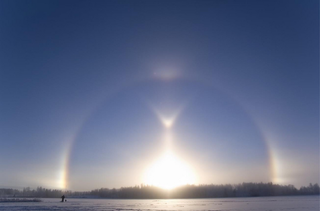The mystery of some atmospheric halos remains unexplained after 5,000 years
For the first time in nearly 5,000 years of observation, researchers have fully cataloged the optical illusion created in the sky when light shines through ice crystals known as atmospheric halos.
The detailed ‘inventory’ of atmospheric halos often looks at atmospheric optical illusions from known sources and explains rarer halos, including those whose origins remain a mystery.
Halos are caused by the accumulation of water ice crystals smaller than 10 micrometers in the atmosphere. The qualities of these atmospheric illusions, such as their color or whether they have white arcs, spots or rings, are determined by the shape and orientation of the ice scattering from and the path that light takes towards these crystals. Often, the type of crystal behind the scattering can be identified by the shape of the halo they create.
Related: What makes Earth’s atmosphere so special?
This atmospheric illusion has been documented by mankind since at least the Babylonian era — which began around 1895 BC — when the phenomenon was detailed on cuneiform tablets. However, thanks to the availability of cameras as a result of the proliferation of cell phones, scientists have never had so much data on this phenomenon at their fingertips.
In addition to an intensive catalog of halos, this new research — which is based on observations collected as late as 2021 — highlights gaps in the study of the phenomenon. The authors behind the inventory also describe promising methods for further observation and processing of the collected data, urging the public to get involved in recording this phenomenon using their mobile phones and digital photography.
The full catalog divides phenomena into 119 different types and also details the conditions such as temperature and humidity required to create them.
Halos that are seen at least once a year are defined as ‘commonly observed’ and are usually formed by the scattering, refraction and focusing of light from the sun or the reflection of the moon by hexagonal ice crystals in irregular, horizontal, or vertical orientations.
Another category – ‘rare halos’ – which includes atmospheric illusions that account for only about one percent of all observations, is further divided into halos of known origin and whose source is unknown and exotic.
“Typically, halos are formed as a result of the interaction of light with hexagonal crystals of water ice,” the scientist and Ph.D. student at the University of Helsinki, Jarmo Moilanen, said in a statement (opens in a new tab). “However, some documented exotic halos cannot be explained in this way.”
Moilanen, who developed an inventory of atmospheric halos with University of Helsinki professor Maria Gritsevich, cites several examples of such exotic halos. “The mystery of the origin of the elliptical halo and the bottling ring (opens in a new tab) unsolved since their discovery in the early 20th century, “said the researcher. “Among the mysterious is the so-called Moilanen arc (opens in a new tab)which I first discovered in 1995.”
The researchers suggest that the key to the production of mysterious atmospheric halos could be ice crystals with anomalous shapes or other mineral crystals scattered in the air.
Gritsevich says research shows that the unusual shape of the exotic halos is caused by human-caused factors, such as atmospheric emissions or the strong electromagnetic fields generated by high-voltage power lines. He added that these factors could disrupt the orientation of the ice crystals in the air, possibly giving rise to exotic halos.
“To unravel such a mystery, samples of ice crystals that form exotic halos were collected specifically in the atmosphere, but this experience also provides more questions than answers,” Gritsevich said in the statement, adding that the visible halos of the atmosphere around other planets may be used in unraveling this mystery.
These include the halos observed and documented in the Martian atmosphere, which can also be used to better understand the Red Planet’s thin, diffused atmosphere.
“These observations prove that hexagonal crystalline clouds of water ice or other minerals exist in the Martian atmosphere,” said Maria Gritsevich. “There are suggestions that halos could be formed by carbon dioxide crystals.”
He added that mathematical modeling of the factors that could lead to the formation of halos could provide valuable information about the state of the Martian atmosphere.
The duo’s research was published in Journal of Quantitative Spectroscopy and Radiative Transfer. (opens in a new tab)
Follow us on Twitter @Spacedotcom or on Facebook.
#mystery #atmospheric #halos #remains #unexplained #years

Comments
Post a Comment